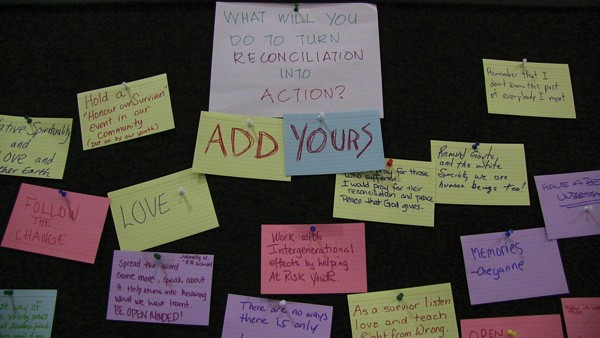Stories of Racism and Resilience Celebrated in Forgiveness and Ceremony

Plenty of tears were shed at the Shaw Conference Centre March 27-30. One after another, Aboriginal people spoke of the trauma caused by their residential school experiences. In every room, volunteers in red vests offered tissues to wipe off the tears and collected the used tissues to burn later in a sacred ceremony.
Representatives of the federal, provincial, and municipal governments and many churches participated. Organizers estimated overall attendance at 20,000.
At the opening ceremony, Edmonton Mayor Don Iveson acknowledged that we were on Treaty 6 Plains Cree traditional territory, on a site where assemblies have happened for thousands of years. “Edmonton will soon have the largest Aboriginal population in the country,” he said, and “it’s time to celebrate that.” The day before, Edmonton City Council voted unanimously to declare a year of reconciliation, starting March 27.
Chairman Hon. Justice Murray Sinclair noted that the Truth and Reconciliation Commission (TRC) process resulted not from a government initiative but from the survivors’ class action lawsuit. Funds for the TRC are part of the settlement. Residential schools existed because of racism, he said, but, “people are not born to be racist. They’re taught racism.” The survivors are determined to make the racism they experienced part of the “national memory for this country so it will never happen again.” Since the commission began in 2009, it has collected well over 6,000 stories from residential school survivors.
I saw a poster that said, “For the child taken; for the parent left behind.” I heard a 55-year-old woman say she was taken from her mother at age 6. When she became a mother at 18, she had no idea how to parent because in the residential school, there was “no peace, no love, only fear.” She said 95 percent of her community became alcoholics, “because that’s how they dealt with their pain.”
A woman talked about being sexually abused by a family member who was traumatized by his residential experience and how she forgave him on his deathbed, and how he wept. She saved the tissues that wiped his tears and brought them for the fire.
A man said he was raised by a wonderful white woman but struggled with addiction and depression until he reconnected with his culture.
Another woman was whipped if she ever spoke Cree in the residential school.
I heard stories of children forced to eat their own vomit, suicide, forced sterilization, police harassment, racist judges, unjust imprisonment, cruel child welfare workers, and much more. It was painful even to listen to these stories.
I also heard stories of forgiveness, which one woman said, “is not for the weak.” All around me I saw Aboriginal people celebrating who they are and who they want to be: their language, art, ceremonies, music, talent, resilience, compassion, honesty, and laughter. I saw the beautiful colours people wore, the joy in their dancing, the generosity and love in their eyes. I heard the power of the drums, inhaled the scent of burning sage and sweetgrass, and felt the energy that held us all together in that sacred place and joined us to a spirit much greater than all of us.





